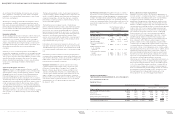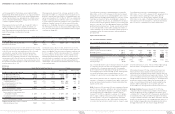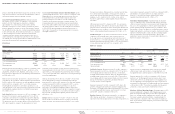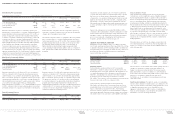Equifax 2013 Annual Report Download - page 14
Download and view the complete annual report
Please find page 14 of the 2013 Equifax annual report below. You can navigate through the pages in the report by either clicking on the pages listed below, or by using the keyword search tool below to find specific information within the annual report.
23 EQUIFAX 2013 ANNUAL REPORT
Effects of Inflation and Changes in Foreign Currency
Exchange Rates
Equifax’s operating results are not materially affected by inflation,
although inflation may result in increases in the Company’s expenses,
which may not be readily recoverable in the price of services offered.
To the extent inflation results in rising interest rates and has other
adverse effects upon the securities markets and upon the value of
financial instruments, it may adversely affect the Company’s financial
position and profitability.
A portion of the Company’s business is conducted in currencies
other than the U.S. dollar, and changes in foreign exchange rates
relative to the U.S. dollar can therefore affect the value of non-U.S.
dollar net assets, revenues and expenses. Potential exposures as a
result of these fluctuations in currencies are closely monitored. We
generally do not mitigate the risks associated with fluctuating
exchange rates, although we may from time to time through forward
contracts or other derivative instruments hedge a portion of our
translational foreign currency exposure or exchange rate risks associ-
ated with material transactions which are denominated in a foreign
currency.
RECENT ACCOUNTING PRONOUNCEMENTS
For information about new accounting pronouncements and the
potential impact on our Consolidated Financial Statements, see Note
1 of the Notes to Consolidated Financial Statements in this report.
APPLICATION OF CRITICAL ACCOUNTING POLICIES
AND ESTIMATES
The Company’s Consolidated Financial Statements are prepared in
conformity with U.S. generally accepted accounting principles, or
GAAP. This requires our management to make estimates and
assumptions that affect the reported amounts of assets and liabilities,
revenues and expenses and related disclosures of contingent assets
and liabilities in our Consolidated Financial Statements and the Notes
to Consolidated Financial Statements. The following accounting poli-
cies involve critical accounting estimates because they are particularly
dependent on estimates and assumptions made by management
about matters that are uncertain at the time the accounting estimates
are made. In addition, while we have used our best estimates based
on facts and circumstances available to us at the time, different
estimates reasonably could have been used in the current period, or
changes in the accounting estimates that we used are reasonably
likely to occur from period to period, either of which may have a
material impact on the presentation of our Consolidated Balance
Sheets and Statements of Income. We also have other significant
accounting policies which involve the use of estimates, judgments
and assumptions that are relevant to understanding our results. For
additional information about these policies, see Note 1 of the Notes
to Consolidated Financial Statements in this report. Although we
believe that our estimates, assumptions and judgments are reason-
able, they are based upon information available at the time. Actual
results may differ significantly from these estimates under different
assumptions, judgments or conditions.
Revenue Recognition
Revenue is recognized when persuasive evidence of an arrangement
exists, collectibility of arrangement consideration is reasonably
assured, the arrangement fees are fixed or determinable and delivery
of the product or service has been completed. A significant portion of
our revenue is derived from the provision of information services to
our customers on a transaction basis, in which case revenue is
recognized, assuming all other revenue recognition criteria are met,
when the services are provided. A smaller portion of our revenues
relate to subscription-based contracts under which a customer pays
a preset fee for a predetermined or unlimited number of transactions
or services provided during the subscription period, generally one
year. Revenue related to subscription-based contracts having a
preset number of transactions is recognized as the services are
provided, using an effective transaction rate as the actual transac-
tions are completed. Any remaining revenue related to unfulfilled units
is not recognized until the end of the related contract’s subscription
period. Revenue related to subscription-based contracts having an
unlimited volume is recognized ratably during the contract term.
Revenue is recorded net of sales taxes.
If at the outset of an arrangement, we determine that collectibility is
not reasonably assured, revenue is deferred until the earlier of when
collectibility becomes probable or the receipt of payment. If there is
uncertainty as to the customer’s acceptance of our deliverables,
revenue is not recognized until the earlier of receipt of customer
acceptance or expiration of the acceptance period. If at the outset of
an arrangement, we determine that the arrangement fee is not fixed
or determinable, revenue is deferred until the arrangement fee
becomes fixed or determinable, assuming all other revenue recogni-
tion criteria have been met.
The determination of certain of our tax management services revenue
requires the use of estimates, principally related to transaction
volumes in instances where these volumes are reported to us by our
clients on a monthly basis in arrears. In these instances, we estimate
transaction volumes based on average actual volumes reported in the
past. Differences between our estimates and actual final volumes
reported are recorded in the period in which actual volumes are
reported. We have not experienced significant variances between our
estimates and actual reported volumes in the past. We monitor actual
volumes to ensure that we will continue to make reasonable
estimates in the future. If we determine that we are unable to make
reasonable future estimates, revenue may be deferred until actual
customer data is obtained. Also within our Workforce Solutions
operating segment, the fees for certain of our tax credits and incen-
tives revenue are based on a percentage of the credit delivered to our
MANAGEMENT’S DISCUSSION AND ANALYSIS OF FINANCIAL CONDITION AND RESULTS OF OPERATIONS continued
24 EQUIFAX 2013 ANNUAL REPORT
clients. Revenue for these arrangements is recognized based on the
achievement of milestones, upon calculation of the credit, or when
the credit is utilized by our client, depending on the provisions of the
client contract.
We have certain offerings that are sold as multiple element arrange-
ments. The multiple elements may include consumer or commercial
information, file updates for certain solutions, services provided by
our decisioning technologies personnel, training services, statistical
models and other services. To account for each of these elements
separately, the delivered elements must have stand-alone value to
our customer. If we are unable to unbundle the arrangement into
separate units of accounting, we apply one of the accounting policies
described above. This may lead to the arrangement consideration
being recognized as the final contract element is delivered to our
customer or ratably over the contract.
Many of our multiple element arrangements involve the delivery of
services generated by a combination of services provided by one or
more of our operating segments. No individual information service
impacts the value or usage of other information services included in
an arrangement and each service can be sold alone or, in most
cases, purchased from another vendor without affecting the quality of
use or value to the customer of the other information services
included in the arrangement. Some of our products require the
development of interfaces or platforms by our decisioning technolo-
gies personnel that allow our customers to interact with our
proprietary information databases. These development services do
not meet the requirement for having stand-alone value, thus any
related development fees are deferred when billed and are
recognized over the expected period that the customer will benefit
from the related decisioning technologies service. Revenue from the
provision of statistical models is recognized as the service is provided
and accepted, assuming all other revenue recognition criteria are
met. The direct costs of set up of a customer are capitalized and
amortized as a cost of service during the term of the related
customer contract.
We have some multiple element arrangements that include software.
We recognize the elements for which we have established vendor
specific objective evidence at fair value upon delivery, in accordance
with the applicable guidance.
We record revenue on a net basis for those sales in which we have in
substance acted as an agent or broker in the transaction.
Deferred revenue consists of amounts billed in excess of revenue
recognized on sales relating generally to the deferral of subscription
fees and arrangement consideration from elements not meeting the
criteria for having stand-alone value discussed above. Deferred
revenues are subsequently recognized as revenue in accordance with
our revenue recognition policies.
Judgments and uncertainties — Each element of a multiple element
arrangement must be considered separately to ensure that appropri-
ate accounting is performed for these deliverables. These
considerations include assessing the price at which the element is
sold compared to its relative fair value; concluding when the element
will be delivered; evaluating collectibility; and determining whether any
contingencies exist in the related customer contract that impact the
prices paid to us for the services.
In addition, the determination of certain of our marketing information
services and tax management services revenue requires the use of
estimates, principally related to transaction volumes in instances
where these volumes are reported to us by our clients on a monthly
basis in arrears. In these instances, we estimate transaction volumes
based on average actual volumes reported in the past. Differences
between our estimates and actual final volumes reported are
recorded in the period in which actual volumes are reported.
Effects if actual results differ from assumptions — We have not
experienced significant variances between our estimates of marketing
information services and tax management services revenues reported
to us by our customers and actual reported volumes in the past. We
monitor actual volumes to ensure that we will continue to make
reasonable estimates in the future. If we determine that we are unable
to make reasonable future estimates, revenue may be deferred until
actual customer data is obtained. However, if actual results are not
consistent with our estimates and assumptions, or if our customer
arrangements become more complex or include more bundled offer-
ings in the future, we may be required to recognize revenue differently
in the future to account for these changes. We do not believe there is
a reasonable likelihood that there will be a material change in the
future estimates or assumptions we use to recognize revenue.
Goodwill and Indefinite-Lived Intangible Assets
We review goodwill and indefinite lived intangible assets for impair-
ment annually (as of September 30) and whenever events or changes
in circumstances indicate the carrying value of an asset may not be
recoverable. These events or circumstances could include a
significant change in the business climate, legal factors, operating
performance or trends, competition, or sale or disposition of a
significant portion of a reporting unit. We have nine reporting units
comprised of Consumer Information Solutions (which includes part of
Online Consumer Information Solutions, Mortgage Solutions and
Consumer Financial Marketing Services), Identity Management (part
of Online Consumer Information Solutions), Europe, Latin America,
Canada Consumer, North America Personal Solutions, North America
Commercial Solutions, Verification Services, and Employer Services.
























